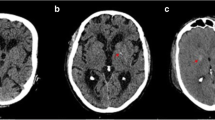Summary
Intracranial calcifications are attributed to many diseases. The globus pallidus is almost always the site of bilateral idiopathic calcium deposits. Computed tomography is superior to conventional skull radiographs in detecting intracranial calcifications. Patients had symptoms that were often explained by other findings. Basal ganglia calcification alone is not a nosological entity and does not justify invasive diagnostic procedures.
Zusammenfassung
Intracraniale Verkalkungen kommen bei zahlreichen Krankheiten vor. Beiderseitige idiopathische Kalkablagerungen finden sich zumeist im Globus pallidus. Zur Entdeckung intracranialer Verkalkungen ist die Computertomographie den konventionellen Röntgenaufnahmen des Schädels überlegen. Die Symptome der Patienten waren aber oft durch ganz andere Befunde begründbar. Verkalkungen in Basalganglien bilden keine nosologische Einheit und sie sind kein alleiniger Grund zu invasiven diagnostischen Maßnahmen.
Similar content being viewed by others
References
Adams, A. E.: Verkalkungen in Basalganglien des Gehirns: Computertomographie und Wirklichkeit. Z. Allgemeinmedizin (in press)
Becker, H. H. Grau, H. Hacker: Endokranielle Verkalkungen in der Computer-Tomographie — Ein Vergleich zum Röntgenbild. Fortschr. Röntgenstr. 126 (1977) 509–512
Becker, H., L. Pflug, K. Hubener, E. Schneider, K. H. Usadel, F. Kollmann: Früherkennung endokranieller Verkalkungen bei Hypoparathyreoidismus. Jahrestag. Dtsch. Ges. Neuroradiol. Mannheim 10.–12. 5. 1979
Bennett, J. C., R. H. Maffly, H. L. Steinbach: The significance of bilateral basal ganglia calcifications. Radiology 72 (1959) 368–378
Bollier, F., M. Bollier, J. Gilbert: Familial idiopathic cerebral calcifications. J. Neurol. Neurosurg. Psychiat. 40 (1977) 280–285
Erbslöh, F., H. Bochnik: Symmetrische Pseudokalkund Kalkablagerungen im Gehirn. Sogenannte idiopathische nichtarteriosklerotische intracerebrale Gefäßverkalkungen (Fahr). In: Scholz, W.: Handb. spez. pathol. Anat. Histol., Bd. XIII/2, S. 1769–1802. Springer, Berlin-Göttingen-Heidelberg 1958
Kazner, E., Th. Grumme, A. Aulich: Axial computerized tomography in neuropediatric diseases. In: Lanksch, W., E. Kazner: Cranial Computerized Tomography, pp. 410–423. Springer, Berlin-Heidelberg-New York 1976
Koller, W. C., J. W. Cochran, H. L. Klawans: Calcification of the basal ganglia: computerized tomography and clinical correlation. Neurology (Minneap.) 29 (1979) 328–333
Lowenthal, A., G. W. Bruyn: Calcification of the striopallidodentate system. In: Vinken, P. J., G. W. Bruyn: Handbook of Clin. Neurology Vol. 6, pp. 703–729. North-Holland Publishing Company, Amsterdam 1968
Netsky, M. G., D. Spiro, H. M. Zimmerman: Hallervorden-Spatz disease and dystonia. J. Neuropath. exp. Neurol. 10 (1951) 125–141
Neumann, M. A.: Iron and calcium dysmetabolism in the brain. J. Neuropath. exp. Neurol. 22 (1963) 148–163
Norman, D., C. Diamond, D. Boyd: Relative detectability of intracranial calcifications on computed tomography and skull radiography. J. Comput. Assist. Tomogr. 2 (1978) 61–64
Ostertag, B.: Die an bestimmte Lokalisation gebundenen Konkremente des Zentralnervensystems und ihre Beziehung zur „Verkalkung intracerebraler Gefäße“ bei gewissen endokrinen Erkrankungen. Virchows Arch. path. Anat. 275 (1929) 828–839
Sachs, C., K. Ericson, U. Erasmie, M. Bergström: Incidence of basal ganglia calcifications on computed tomography. J. Comput. Assist. Tomogr. 3 (1979) 339–344
Slager, U. T., J. A. Wagner: The incidence, composition, and pathological significance of intracerebral vascular deposits in the basal ganglia J. Neuropath. exp. Neurol. 15 (1956) 417–431
Strassman, G.: Iron and calcium deposits in the brain. J. Neuropath. exp. Neurol. 8 (1949) 428–434
Virchow, R.: Kalk-Metastasen. Virchows Arch. path. Anat. 8 (1855) 103–113
Author information
Authors and Affiliations
Additional information
Dedicated to Professor Dr. K. J. Zülch on the occassion of his 70th birthday.
Rights and permissions
About this article
Cite this article
Adams, A.E. Basal ganglia calcification. Characteristics of CT scans and clinical findings. Neurosurg. Rev. 3, 201–203 (1980). https://doi.org/10.1007/BF01647130
Issue Date:
DOI: https://doi.org/10.1007/BF01647130




